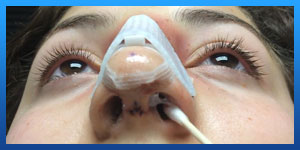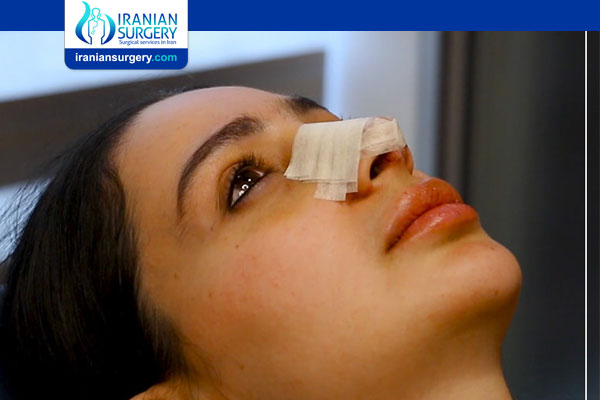After Rhinoplasty Surgery in Iran
Recovery time After Rhinoplasty Surgery in Iran (In hospital)
Immediately Following Surgery:
. An adult should stay with you for at least the first 24 hours after surgery. Rest is absolutely necessary.
. You should rest with your head elevated in a recliner or with at least 2 pillows for at least the first week after surgery. Try not to sleep on the side of your face but rather sleep with the back of your head on the pillow. Some patients prefer an airline type pillow for comfort. Also popular is the common pillow called a “husband.” This is the large pillow that has extensions that go under the arms and supports the patient.
. Take the prescribed pain medications before you begin to feel discomfort. It is easier to prevent pain than control it.
. Restrict your activities the day of surgery and several days afterwards. It is not unusual to require 10 to 14 days before you are feeling back to normal, and before you can resume physical activity.
. Caution: If you suddenly sit up or stand from a lying position you may become dizzy. If you are lying down following surgery, make sure you sit for one minute before standing. Stand up slowly to provide time to steady yourself. If you feel dizzy when you sit or stand, you should lie back down immediately to minimize the possibility of fainting.

Read more about : Blackheads after rhinoplasty
Read more about : When can i touch my nose after rhinoplasty?
. Packing: A nasal packing is sometimes placed into the nostrils, especially if your surgery is also to relieve a nasal breathing obstruction. This packing is removed a few days following surgery. Our doctor usually sees you within a few days to assist in the removal of packing and to review instructions.
. A small bandage is placed between the bottom of the nose and the upper lip. This is changed as often as needed during the day. A small amount of oozing is ordinary and expected. It should not concern you. The bandage may be changed one or a dozen times. The loosely closed incision allows blood to escape rather than flow back up into the nasal tissue. Most of this oozing stops by the evening of surgery or by the following morning. The drip pad, placed below the nose, can ordinarily be discontinued the morning following your operation. A small amount of red-pink serum is to be expected. Just dab it away.
. A small silicone splint is placed atop the upper two-thirds of the nose at the completion of the rhinoplasty. This splint acts both as a protector for the freshly operated nose and helps to maintain the position of the newly sculpted nasal bones. The splint is removed in one week. Do not allow it to get wet or it may separate prematurely.
. After general anesthesia or I.V. sedation, clear liquids should be initially taken. Over the next several days a high calorie, high protein intake is very important. Nourishment should be taken regularly. You should prevent dehydration by taking fluids regularly. Keeping well hydrated also prevents nausea and vomiting. Try not to miss a single meal. You will feel better, have more strength, less discomfort, and heal faster if you continue to eat. Decreased activity may promote constipation so you may want to add more raw fruit to your diet and be sure to increase your fluid intake. Avoid straining when going to the restroom. Getting a laxative or a stool softener may be beneficial.
The First Week after RHINOPLASTY Surgery
. Ice: During the day and evening of surgery, cold compresses are used continuously over the nose and eyes to minimize swelling and control bruising. The ice packs should be used for the first 2 to 3 days as much as possible. A good way to do this is to crush up the ice and place it into a zip lock bag. Wrap a thin towel around the ice pack and place it over the nose and over the eyes.
. Puffiness: Puffiness or swelling of the eyelids is always most pronounced on the second morning following any facial plastic surgery (i.e., surgery on Monday, most swelling on Wednesday). It usually regresses quickly in the next few days. This normal and expected observation is no cause for concern.
. Bruising: Bruising and discoloration around the eyes is extremely variable. However, the majority of patients do experience minimal black and blue. Careful adherence to the recommended pre-operative medication instructions is imperative. A few patients, despite taking all precautions, will develop marked bruising in the eyelids. Even this bruising is usually resolved by the end of the first week.
. Nasal Stuffiness: Invariably, there is some nasal stuffiness during the week after surgery. The external edema (swelling) is reflected internally, but the mild blockage will improve steadily. The application, twice daily, of a small amount of prescription ointment just inside the nostrils, acts to lubricate the surgically sutured area and prevent crusting.
. Any crusting that does form can be gently removed with a peroxide dampened Q-tip. However, it is imperative to avoid extensive manipulation in this area. Do not blow the nose. Do not use nose drops.
. Nasal Discharge: For the first few post-operative days, you may expect a small amount pink-colored water nasal discharge. Usually, a facial tissue touched to the nostrils is all that is required. Occasionally, reapplication of a small gauze bandage beneath the nostrils may be more convenient. Any gauze that has continuous persistent show of bright red blood should be reported to me.
. Bleeding on the third, fourth, or fifth day occurs in less than one-percent of cases. First aid for such a rare occurrence is as follows: Lie down and elevate head. Place cold compress on the nose. If available, saturate a piece of cotton with nose drops or Visine, and place it in the bleeding nostril.
. Pain: Discomfort following rhinoplasty is usually limited to the first two or three days following the procedure. In most cases, it is moderate in nature. Severe pain is rarely a consequence of facial plastic surgery. The prescription for pain tablets that you have received should be used the 1st day after surgery and then on an as needed basis thereafter.
. Nasal Appearance with Cast: During the first week, you may notice that the nasal tip is slightly elevated. This is a constant, temporary factor following all rhinoplasties. The position of the nasal tip at this time has little relationship to the final result. The tip will slowly drop to its new lower position over several days or weeks. The nasal splint will be removed at the end of the first week.
. Exercise after rhinoplasty: Exercise must be limited during the first week. While relaxed ambulation about the home and local shopping, dining or visiting is encouraged: any lifting, pulling or straining must be avoided, as it may cause bleeding.
. Avoid Blood Thinners: Do not use Aspirin until after the first week. Please refer to blood thinner sheet. Alcohol is a potent blood vessel dilator and, in the post-operative condition, can promote swelling of the surgical area and even bleedings. It is best to avoid Alcohol intake for at least one week following surgery.
. Stiches will be removed at 1 week. After all stitches have been removed, the scar will appear a deep pink color. There will be varying amounts of swelling in and around the scars themselves. With the passage of time, the pink will become white, the firmness of the scar will soften, and they will become less noticeable. Each individual varies with respect to healing, but it takes approximately one year for these changes to occur in most scars. Beginning 6 weeks after the surgery, application and gentle massage with vitamin E, cocoa butter, or Mederma may promote softer, less conspicuous scar. Incisions can be covered with makeup 10 days after surgery.
After The First Week:
. Nasal Appearance: At the time of nasal splint removal, you will have your chance to see the new nose. It will appear quite swollen but, in most cases, even in this swollen condition, the improvement can be appreciated. It is not a time for critical evaluation since, over the next few weeks, daily changes progress toward the final result.
. In most cases, the appearance at six to eight weeks approximates the final shape. Many factors determine how quickly, or slowly, the nose assumes the final appearance. The most influential determinant is skin type. Skin that is thicker and oilier is certain to retain edema and swelling longer that skin that is drier and thinner. Individuals vary in healing potential. The nose will continue to heal over a long period of time with subtle changes occurring over years of surgery. Our goal is to provide a long term result which will last the person’s entire life.


